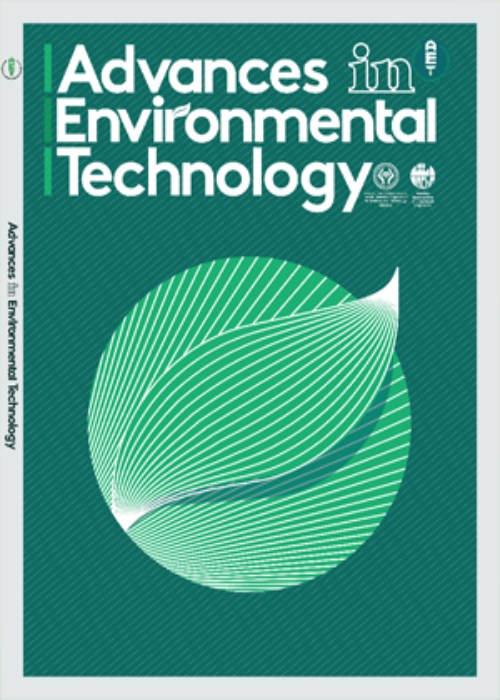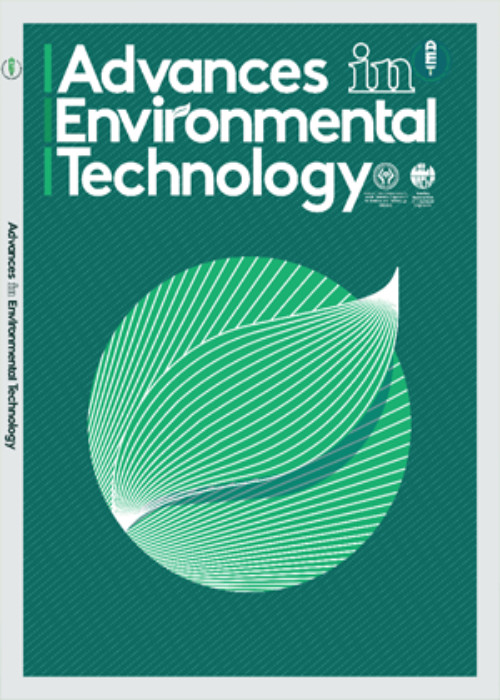فهرست مطالب

Advances in Environmental Technology
Volume:9 Issue: 3, Summer 2023
- تاریخ انتشار: 1402/06/10
- تعداد عناوین: 6
-
-
Pages 165-173The current work investigated the effect of ZnS and ZnS/ZnO assembly on the photocatalytic removal of Reactive Red 66 from an aqueous solution. The photocatalytic activities were carried out using both UV irradiation and visible light, and the effects of various operating parameters, such as pH, catalyst loading, dye concentration, and contact time, were studied. The results showed that the ZnS/ZnO heterostructure exhibited a higher dye removal percentage than ZnS alone and assisted in the photodegradation of Reactive Red 66. Maximum adsorption was found at pH 2 and 5, indicating that the dye removal was strongly pH-dependent. The highest dye removal efficiency under UV light was 77.7 and 91.7% using ZnS and ZnS/ZnO, respectively. Furthermore, the degradation percentage of Reactive Red 66 by ZnS and ZnS/ZnO decreased to 43.3 and 75.2% under visible light. The enhanced photocatalytic activity of the ZnS/ZnO heterostructure is attributed to its high absorption of light, efficient separation of electron-hole pairs, and quick surface reaction in the heterostructure.Keywords: ZnS, ZnS, ZnO heterostructure, Reactive Red 66, Photocatalytic degradation
-
Pages 174-193The treatment of industrial wastewater by economical and efficient methods is being explored to improve treatment efficiency and costs. Wastewater treatment via biological methods to reduce carbonaceous matter is common in the form of an activated sludge process (ASP). In the current work, the aerobic decomposition of waste was carried out in a reactor with constant stirring with a Rushton type turbine. The optimum values of the flow rate of air were obtained for two reactor impeller configurations for better waste degradation. The extent of degradation in the stirred tank reactor was studied for different values of impeller clearances. Two configurations, C1 and C2, were investigated. It was observed that under a continuous air supply for 36 hours, the impeller configuration C2 provided 80% degradation compared to 74.4 % for C1. Increased values of superficial gas velocity (UG) and impeller speed resulted in decreased degradation due to shear stress on microorganisms for two impeller configurations. The hydrodynamic study confirmed that the impeller configuration C1 required less power consumption than C2 for the same operating condition. The k-epsilon turbulent model and the population balance model were used in combination. The models were validated with the experimental results of the hydrodynamic parameters for the values of operating parameters over a considerable range. The forecasting of mass transfer coefficients from different models was compared with practically determined values for the two configurations of impeller positions in the tank.Keywords: Biological treatment, Optimization, small scale industrial wastewater, coefficient, Configurations hydrodynamics, Fluid dynamics
-
Pages 194-214Synthesis of nanocellulose using crop residue rice husk is an innovative method. Morphological and structural characterizations of nanocellulose were analyzed. The rice husk based nanocellulose had a particle height of 5.7 nm and a crystallinity index of 70%. Raw rice husk comprises 35% cellulose, 22% hemicellulose, 19.1% lignin, and 20% ash. Defluoridation of water samples is an imperious provocation for the advancement of society. According to World Health Organisation (WHO) guidelines, a fluoride concentration of more than 1.5 milligrams per litre leads to dental problems and bone deficiency. The appropriate defluoridation practice was selected to avoid these problems. Cost-effective nanocellulose from rice husk was used as an adsorbent to purify a fluoride-rich aqueous solution in batch experiments on a lab scale. Response of dose, temperature, time, pH, and initial ion concentration on adsorption capacity and removal efficiency were deliberated. In batch experiments, the highest removal efficiency of fluoride from aqueous solution was 74% at a 120 min time, 2 mg/l initial ion concentration, 30 ˚C temp, 0.9 g adsorbent dose at pH 2. According to WHO standards, fluoride concentrations above 1.5 mg/l cause tooth and bone insufficiency. Regeneration showed that the adsorbent was cost-effective and reusable. Two, three, and four-parameter isotherm models were applied to the experimental data. The Freundlich, Langmuir, Temkin, Redlich-Peterson, and Baudu isotherm models and the pseudo-second-order kinetic and intra-particle diffusion models best fit the data. The studied thermodynamic constraints showed the physical adsorption of fluoride.Keywords: Nanocellulose, characterization, Batch Study, Adsorption, Defluoridation
-
Pages 215-226The current study describes an easy, enviro safe, affordable, and time-saving method to produce Magnesium Oxide (MgO) nanoparticles employing the leaf extract of Cymbopogon citratus (Lemon grass) as a reducing and capping agent. X-ray diffraction spectroscopy (XRD), Fourier transform infrared (FT-IR) spectroscopy, scanning electron microscopy (SEM), energy dispersive X-ray spectroscopy (EDX), high-resolution transmission electron microscopy (HR-TEM), photoluminescence spectroscopy (PL), and UV-visible studies were used to characterize the nanoparticles. SEM and TEM analysis of nano MgO revealed that agglomerated particles had nearly spherical morphologies, and the average crystalline size was 25 nm, according to the XRD investigation. The bandgap of the synthesized nanoparticles was calculated to be 3.7 eV using a Tauc plot from the UV-visible spectrum. The photocatalytic degradation of the crystal violet (CV) dye in the presence of sunlight was tested, and antibacterial activity was thoroughly investigated for both the Gram-negative (Escherichia Coli) and Gram-positive (Staphylococcus aureus) pathogens utilizing the MgO nanoparticles. The engineered MgO nanoparticles exhibited excellent utility potential for the photocatalytic degradation of the mentioned dye and antibacterial activity against the two pathogens.Keywords: Green synthesis, MgO nanoparticles, photocatalysis, Antibacterial activity
-
Pages 227-241Three vertical sub-surface flow (VSSF) constructed wetland (CW) systems (CW-1, CW-2 and CW-3) filled with different filter media, each 4 m2 in area, planted with Arundo donax was operated for 4 years for treating dairy farm wastewater. The vertical CW systems received high fluctuations in influent concentration and loads i.e. BOD (26 to 619 mg L-1 and 1.5 to 34 g m-2 d-1), TSS (165 to 643 mg L-1 and 9.1 to 24 g m-2 d-1), TP (16 to 49.9 mg L-1 and 1.2 to 2.7 g m-2 d-1) and NH4-N (24.5 to 76.2 mg L-1 and 1.3 to 4.2 g m-2 d-1) during the assessment period. Average annual removal rates showed fluctuations in removal of BOD (70.5 to 92.9%), TSS (82.5 to 97.5%), TP (51.1 to 91.9%) and NH4-N (34.6 to 69%). This shows that the removal of BOD is very sensitive to inlet load fluctuations in CWs. High inlet loads may confine good nitrification that affects ammonium-nitrogen removal while TP removal rate reduced when inlet TP loads reduced. The average concentration of the pollutants (BOD, TSS, TP and NH4-N) in the treated effluent showed noticeable decrease: 43.4 to 16.1 mg L-1 for BOD; 43.3 to 11.7 mg L-1 for TSS; 17.9 to 3.1 mg L-1 for TP and 33.2 to 22.7 mg L-1 for NH4-N. Thus from the outcomes of the current study, it can be concluded that the VSSF CW system may provide promising outcomes despite there is fluctuations in the influent loads.Keywords: Vertical sub-surface flow constructed wetland, influent loads, dairy farm wastewater, Organic matter, BOD
-
Pages 242-257Pollution from atmospheric particulates is a severe environmental problem of universal concern. Fine and ultra-fine particulates harbour the ability to enter the bloodstream and carry with them trace metals like copper, cadmium, iron, lead, and zinc that can cause toxic and carcinogenic effects. This necessitates an increased emphasis on the detailed chemical characterisation of atmospheric particulates. The current study identified six locations in the Vapi industrial area. In these six locations, coarse particulate matter (PM10) samples were collected simultaneously for 20 days to determine the Elemental Carbon (EC), Organic Carbon (OC), Water-soluble ions (WSIs), and major and trace elements. The concentration of PM10 was observed to be in the range of 115.88 to 226.5 μg/m3, exceeding the NAAQS standard value of 100 ug/m3. The chemical analysis results suggested contributions from total carbon, water-soluble ions, and elements varied between 45 to 48%, 20 to 23%, and 29 to 33% of PM10 mass, respectively. Chemical mass balance (CMB) and Positive matrix factorisation (PMF) models were employed separately for carrying out source apportionment studies. CMB demonstrated influence from various sources: 35% from fossil fuel combustion that included industries, 22.90% from crustal or soil dust, 19.12% from biomass burning, 16.18% from vehicular emissions, and 6.79 % from secondary particulates. The PMF receptor model showed the influence from various sources as 25.75 % from fossil fuel combustion, 22.13 % from crustal or soil dust, 16.95% from vehicular emissions, 14.53% from biomass burning, 11.49% from industrial emissions, and 9.16% from secondary aerosols. Thus, this study shall help in formulating pollution abetment strategies.Keywords: Particulate matter, Receptor model, CMB, PMF, Vapi


